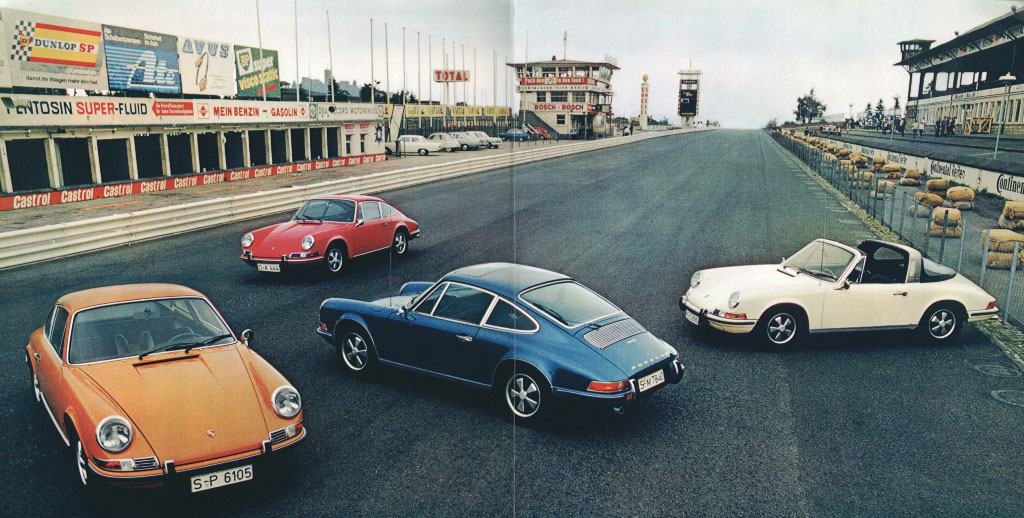
Porsche Press kit 1970 - landing page
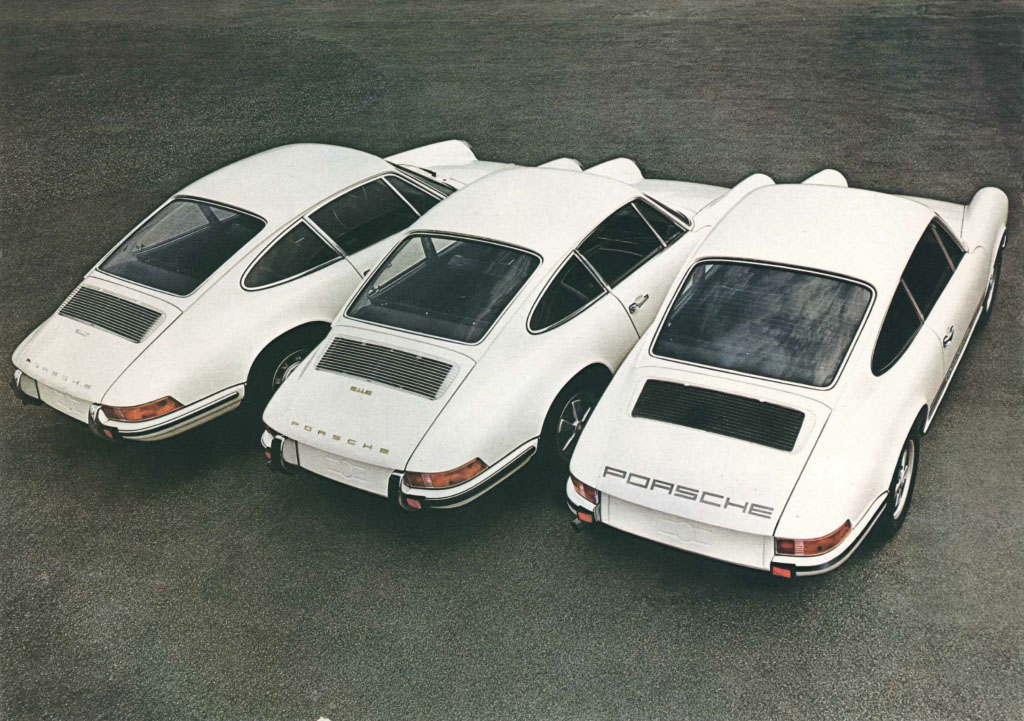
The vehicles of the 911 series are among the fastest and most comfortable touring cars, with a decidedly sporty accent. The 1970 models are the result of a careful development and refinement of the proven and tested basic concept. The emphasis here was on improvement driving comfort and safety via the increase in the power and elasticity of the six-cylinder engines.
| PORSCHE 911 T | 6 cylinder, 2.2 l, 125 hp carburettor engine 205 km / h, four-speed transmission |
| PORSCHE 911 E | 6 cylinder, 2.2 l, 155 HP injection engine 220 km / h, five-speed transmission |
| PORSCHE 911 S | 6 cylinder, 2.2 l, 180 hp injection engine 230 km / h, five-speed transmission |
The basic technical concept is the same for all the three models. The arrangement of air-cooled boxer engines in the rear enables the optimal compromise between aerodynamics, space requirements and occupant safety.
The Dual-circuit braking system acting on four internally ventilated disc brakes and the independent suspension chassis have passed their tough test in many racing events as well as the six-cylinder boxer engines.
The three models 911 T, E and S are differentiated in terms of equipment and performance, delivered in Coupe and and, for lovers of open-top driving, also in the Targa versions.
Every model can be supplemented individually with additional technical equipment on request, whereby from the variety of possibilities, e.g. the selectively automatic transmission "Sportomatic" for the 911 T and 911 E.
The vehicles of the 911 model series have the characteristic Porsche streamed lines. This is not an end in itself for the sake of the fashionable effect, rather it is explained in the technical function. The streamlined, smooth surfaces even on the underside body allows for its low air resistance high performance with reasonably sized and therefore economical engines.
The self-supporting all-steel body is welded to one unit with a frame-floor group. The passenger compartment is a deformation-resistant safety cell, the front and rear sections are designed as crumple zones. The front fenders can be unscrewed, all cables, lines and operating rods are protected in the frame tunnel of the closed body floor. The body underside is treated with PVC underbody protection as standard and the galvanized sheet metal in exposed places receive additional corrosion protection.
The air-cooled six-cylinder engines of the 911 models are basically the same in terms of their technical structure in contrast to the mid-engine design of the VW-PORSCHE 914 installed behind the rear axle. This gives a plus at interior that can accommodate two jump seats. The 6 cylinders are in boxer design (3 right and left of the crankcase) and screwed to the heavily ribbed light metal cylinder heads. The overhead valves are arranged in a V-shape and are controlled via rocker arms each with an overhead camshaft per cylinder bank. The forged crankshaft is has eight supports. A dry sump lubrication ensures the even supply of all lubrication points with oil (e.g. even at high cornering speeds). The oil is cleaned via in a filter located in the main flow and cooled via an oil cooler, which is thermostatically controlled.
The alternator and the axial fan for the cooling of the engine is activated by a V-belt powered from the crankshaft.
In contrast to the 911 E and S engines, the T has two triple downdraft carburettors that delivers to the cylinders' short intake manifolds a fuel-air mixture supply. Its power and torque curves run flatter than that of the two sister, but still is nott shy of comparison with other sporty engines. Acceleration from 0-100 km / h takes 10.0 sec.
In contrast to the 911 T, the fuel-air mixture is supplied with a mechanical intake manifold gasoline injection. In addition to the higher performance (power is 155 or 180 hp resp.), the Bosch injection system the following advantages: Lower fuel consumption with changing speeds, better pulling power in all speed ranges, insensitivity to temperature and air pressure fluctuations.
The main difference between the two engines is in their performance characteristics.
While the "E" engine is already pulling from lower rpm, the "S" engine needs to develop its power much higher speeds (approx. 5500 rpm). That requires frequent shifting and a stronger extension of the gears to achieve full engine power. So the 911 S engine is matching a more sporty use, while the "E" motor is more tailored to the requirements of everyday traffic.
All 6-cylinder engines, including the 914/6, are equipped with high voltage capacitor ignition.
The 911 E and 911 S models have the Porsche five-speed gearbox as standard; the 911 T and E can also be delivered with the selective automatic transmission, the "Sportomatic".
Driving performance:
The 6-cylinder engine of the 914/6 allows the 940 kg vehicle a top speed of 200 km / h. The acceleration time from 0 - 100 km / h is 9.9 seconds, the power to weight ratio 8.5 kp / PS. The 914/6 comes with the PORSCHE five-speed gearbox as standard equipped. If desired, this model can be equipped with the selectively automatic Transmission, the Sportomatic.
The chassis with independent suspension is basically the same in all the PORSCHE 911 models. Only variations are the technical individual solutions according to the different Performance character of the vehicles.
The individually suspended wheels are supported by wishbones in connected to shock absorber struts. The suspension takes place with one adjustable torsion bar lengthways for each side. In the 911 E, the suspension and damping are taken over by a hydropneumatic strut, which automatically regulates the level. The 911 S has an additional anti-roll bar.
Individually suspended wheels guided by semi-trailing arms and by transverse adjustable spring bars and a progressive hollow rubber spring. Double-acting hydraulic shock absorbers. The driving force is transmitted to the rear wheels. All joints are maintenance-free. The 911 S also has an anti-roll bar.
All 911 models are equipped with a dual-circuit braking system, which acts on 4 internally ventilated disc brakes. The brake segments adjust themselves automatically, the handbrake acts on independent brake drums on the rear wheels.
The rack and pinion steering is divided into three parts for safety reasons with maintenance-free universal joints. Together with the four-spoke steering wheel, the deep hub and the large, padded horn button gives the driver the greatest possible safety.
The design of the interior and the dashboard the PORSCHE 911 models follows (as with the VW PORSCHE 914) the demand for quick and easy handling of all operating commands and the clarity of all control instruments.
The interior is so generous that the driver and passengers have unrestricted freedom of movement. The rear jump seats also accomodates additional passengers for short distances. When folded forward, they yield an additional flat surface for housing baggage.
The anatomical front seats are located deep in the center of gravity of the car and their shell shape provides the driver with lateral support. Each individual seat has multi-adjustable backrests and length adjustment, providing the passenger the opportunity to relax on long journeys.
All instruments are glare-free and in the driver's field of vision. Without taking your hands off the steering wheel, via 2 combination switches on the steering column, the driver can operate the three-stage wipers, the windscreen washer, the indicators, flasher and the dimmer switch. Incidentally, the PORSCHE 911 models have all the equipment details, which increase driving comfort and safety, e.g .:
Laminated safety windshield, safety glass on Rear and side windows, electrically heated rear window, electric windscreen washer, halogen headlights, reversing lights, hazard warning lights, tachometer, oil temperature and pressure gauges, padded on top and bottom glare-free dashboard, mounting points for seat belts, hand throttle, draft-free Ventilation of the interior, stepless and separate adjustable heating and ventilation system with multi-stage blower.
It is worth mentioning that the hazard warning lights between the front and rear lights are separated so that if there is a damage to the front lights, e.g. a rear-end collision, the rear lights are still functional.
The technical changes and equipment changes the PORSCHE 911 models are mainly used to increase driving safety by increasing the engine power and facilitating the service organs.
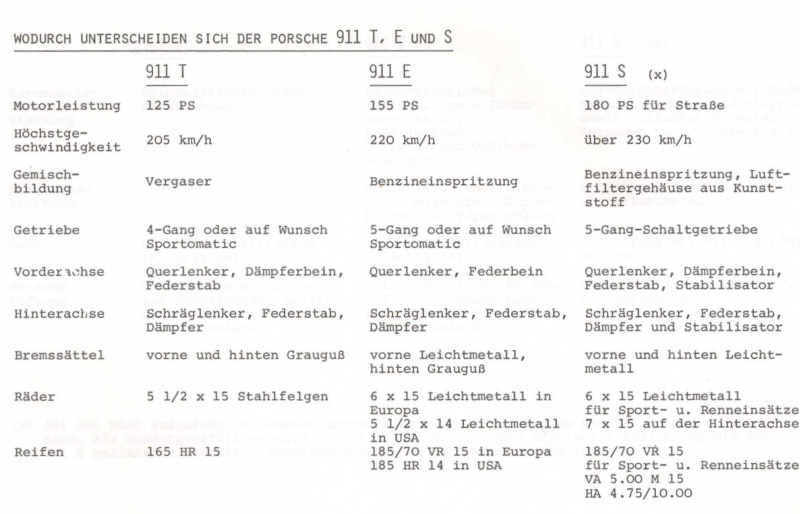
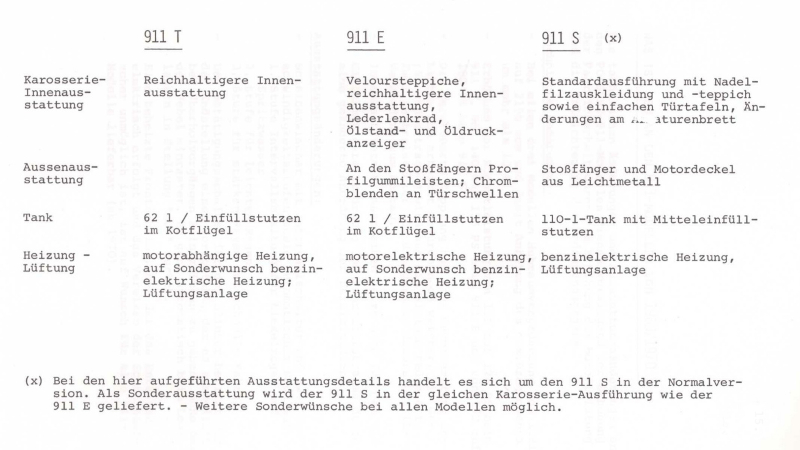
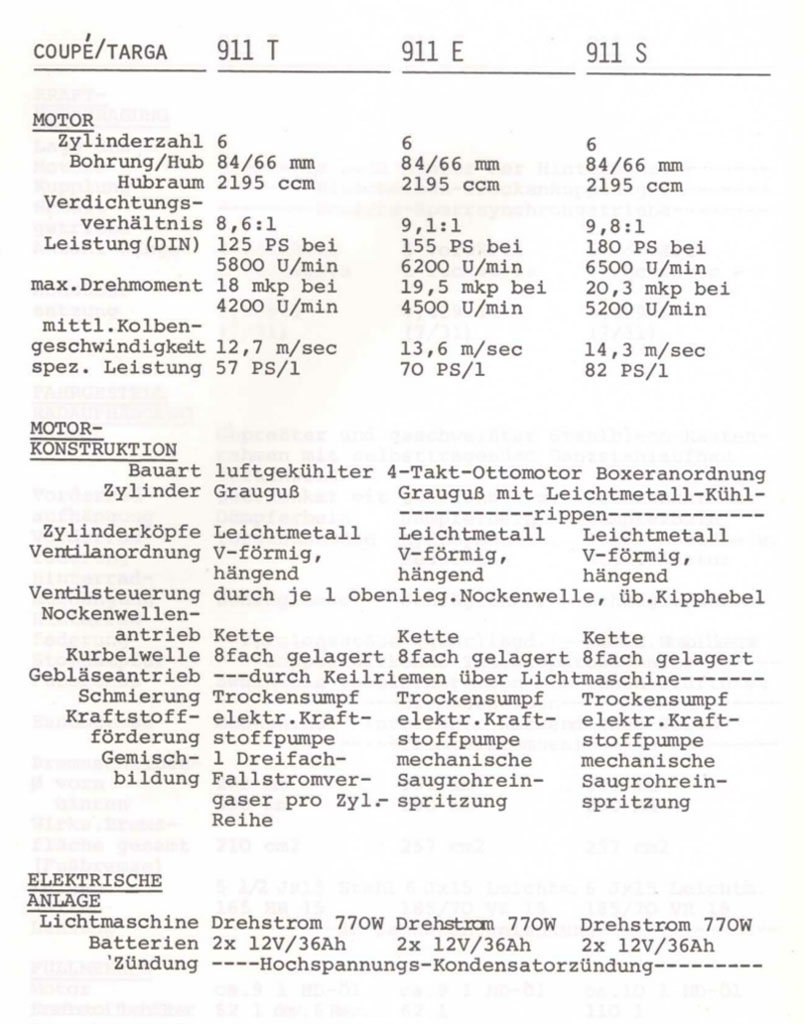
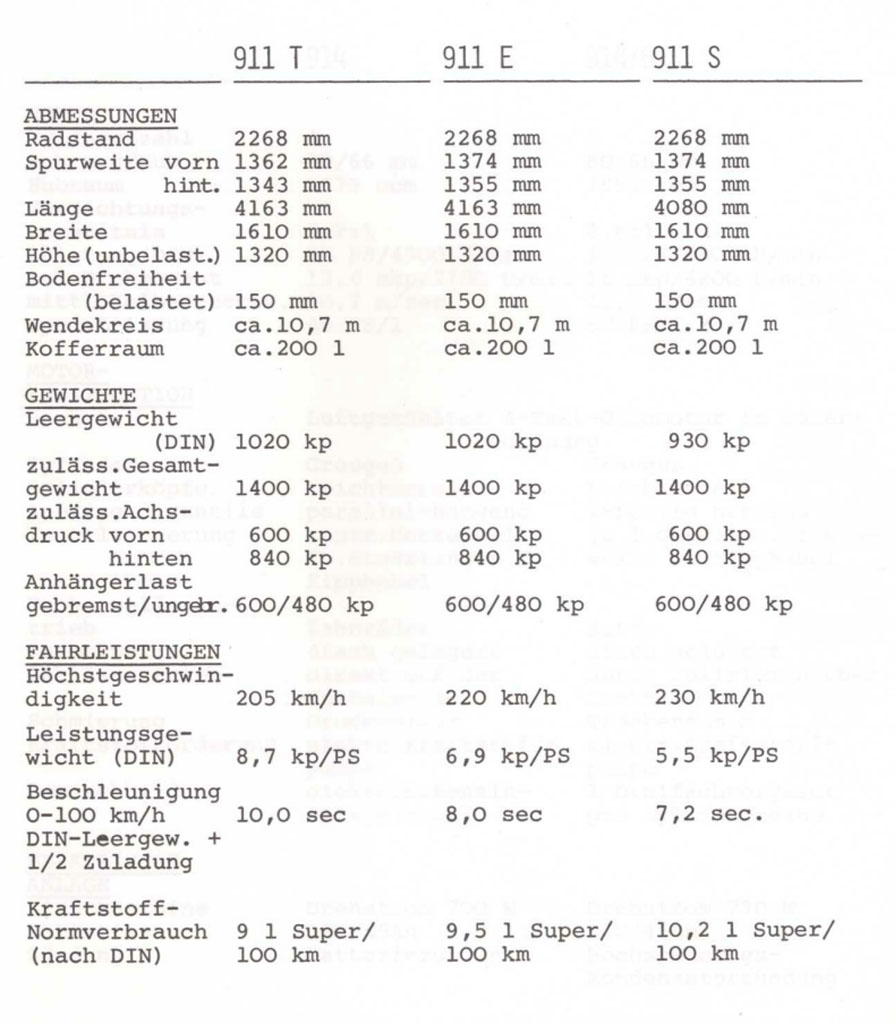

Porsche Press kit 1970 - landing page
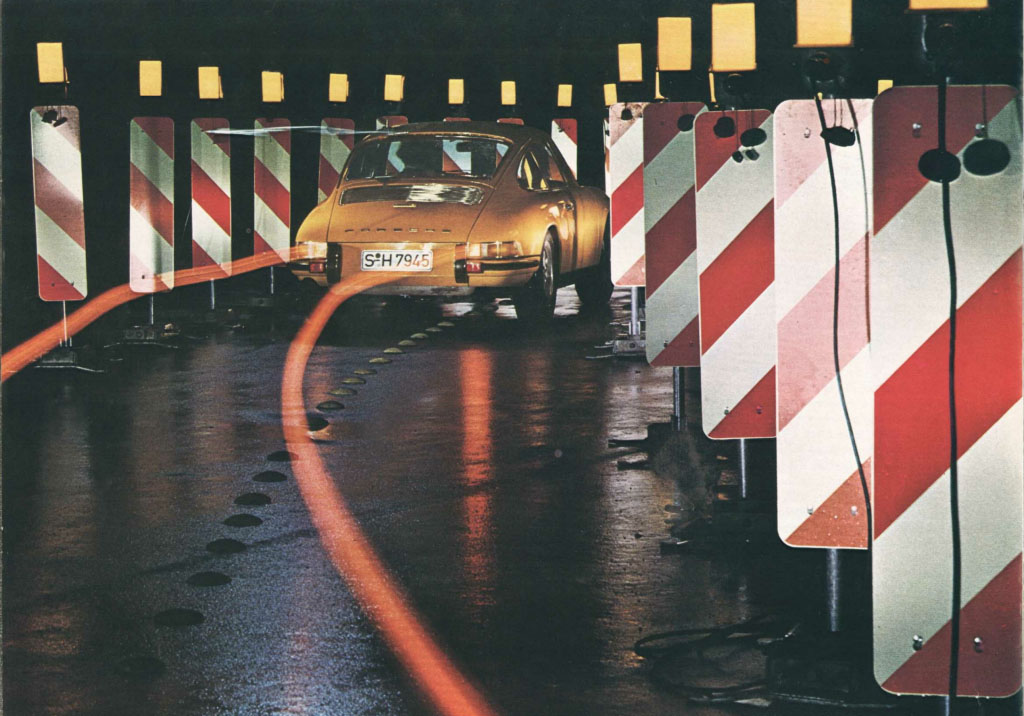
Leaflet Porsche 911 T, E, S: they are faster, with grater safety, but ...

Leaflet Porsche 911 T, E, S:

Porsche Press kit

Porsche Literature

Our Porsche Cars